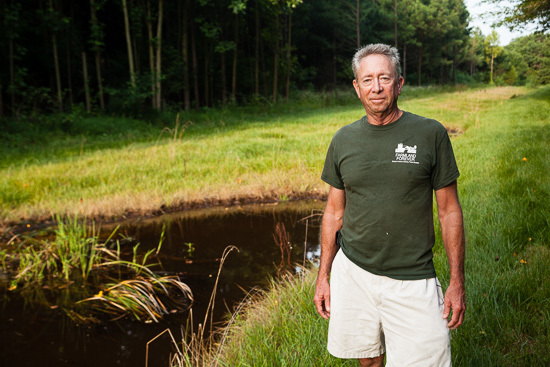Maryland farmer develops solution for agriculture runoff
Sam Owings combined his experience as a farmer and developer to address agriculture runoff
The word “pollution” tends to bring to mind images of dark smoke billowing out of smokestacks or fluorescent-colored water spilling out of pipes. But there are other types of pollutants in the Chesapeake Bay region and they come from a somewhat unexpected place: agriculture.
Agriculture is the single largest source of nutrient and sediment pollution in the Chesapeake Bay region. Nutrients, such as nitrogen and phosphorus, feed algal blooms that create harmful conditions for the Bay’s fish. Too much sediment can cloud the water and smother bottom-dwelling animals. These pollutants are difficult to control because, instead of spilling out of pipes, they run off of large fields when it rains. Sam Owings, a farmer in Chestertown, Maryland, knew the challenges of controlling agricultural runoff, so he decided to develop his own solution.
Owings knows farming, and he knows stormwater. He grew up on a farm where he worked until he was 30 years old, after which he started a site development contracting business. “I learned a lot about soil erosion and soil conservation in agriculture,” he said, “and then I learned about stormwater control in site development.”
After returning to farming 15 years ago, he combined that knowledge to develop what he calls the “cascading system.” The system, which he built and tested on his farm, is a strip of four 40 by 140 foot trenches in a grass waterway between two of his fields. The grass waterway is an area where rainwater—and farm runoff—naturally collect from over 100 acres of surrounding land and are funneled toward a nearby creek.
“The idea behind it is to reduce stormwater flows from the land into state waters,” Owing said. It’s designed to slow down the flow of water by having it run through the strip of basins, filling up each one before allowing any water to discharge into the creek. After the rain stops, the remaining water sits in the basins to either evaporate or absorb back into the ground. Owings specifically placed the basins in an area that receives concentrated runoff from a large area of over 100 acres.
After receiving a research grant from Maryland Industrial Partnerships, Owings teamed up with University of Maryland professor Dr. Allen Davis to conduct a two year study of the system. The results Davis got were telling: of the water that entered the cascading system, 56 percent was not released out the other end and into the creek. The system also captured 65 percent of sediment and over half the nutrients.

Even with the apparent success of the cascading system, Owings isn’t done. He developed a “chain system,” or what he described as a “filter strip on steroids.” Unlike the cascading system, which was designed for concentrated, high-flow areas, the point of the chain system is to collect regular runoff from fields. “The concept is simple,” he said about both of his systems. “You can take an existing filter strip and retrofit it into these.”
The suitability to existing farms is one of the advantages Owings sees in both of his systems. “With many environmental programs, [farmers] have to give up tillable land,” he explained. But since the cascading and chain systems are in grass waterways, which are generally not utilized by farmers, “you’re just making the land more efficient.”
All in all, the project seems to be working for Owings. Now, he’s working with Earth Data to try and get his cascading system certified as a best management practice, a designation that means it is an efficient and effective practice to combat agricultural runoff.
When asked why he developed these systems, Owings’ answer was straightforward: “Farmers are inherently problem-solvers. Agriculture pollution is a problem, and so why not work on a solution?”

Comments
That is a great idea that farmer has. It goes hand and hand with what I'm trying to do in dealing with wastewater.
Thank you!
Your comment has been received. Before it can be published, the comment will be reviewed by our team to ensure it adheres with our rules of engagement.
Back to recent stories